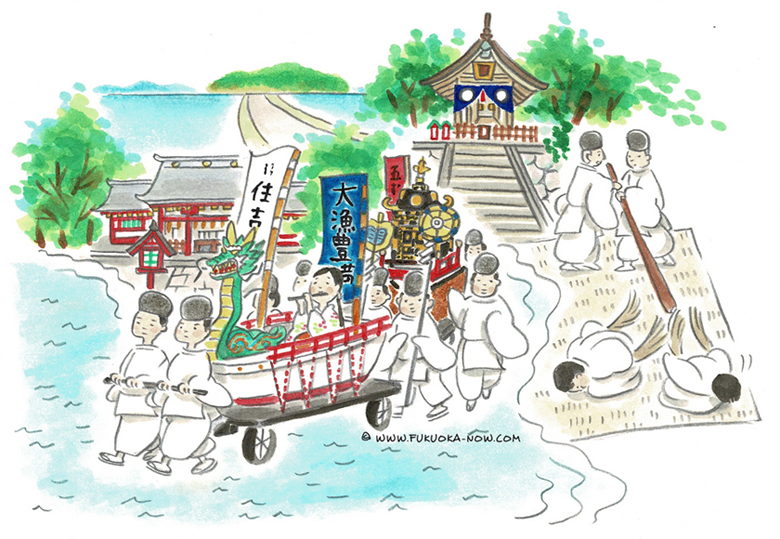Hakata Culture vol.157
Shrines and the Surprising Connections Between Land and Sea

In Japan, shrines hold various festivals throughout the year, but some of them may seem a little peculiar. One example of this is the Shiohi-sai held every year on April 3 at Sumiyoshi Shrine in Hakata Ward. Shiohi means low tide, and the festival is held to pray for bountiful fish harvests and the safety of fishermen, but Sumiyoshi Shrine is nowhere near the coast. So, why is this festival held here?
Long ago, a deep arm of Hakata Bay stretched inland and Sumiyoshi Shrine was actually located next to the sea. For this reason, the shrine was home to the guardian deity of sea voyages. Back then, the Shiohi-sai consisted of loading a portable shrine on a boat at Sumiyoshi Shrine and sailing it to another shrine on Cape Aratsu (now Nishi Park). Because this route is now connected by land, parishioners dress in old garb and parade a portable shrine over land.
Another shrine that has been home to a guardian deity for sea voyages since olden times is Shikanoshima Shrine on Shikanoshima in Higashi Ward, which is said to have been built by the ancient seafaring Azumi people of the Jomon era. Every year, on April 15 and November 15, a festival called the Yamahome-sai is held at Shikanoshima Shrine. Originally, people would pay their respects to the mountains and pray for bountiful hunting and fishing for the year.
Technically, the festival is actually two festivals: one in the spring to pray for bountiful crops and fishing and one in the fall to give thanks for the year’s harvest from both the land and the sea. Some people may find it odd that a seaside shrine would hold a festival to pay respect to the mountains, but it is possible that the people of olden times realized even back then that treating the land properly would also keep the sea beautiful and bountiful. Tracing the history of these shrine festivals not only reveals surprising connections between the land and the sea, but it also sheds light on how these festivals came to be celebrated in the first place.
神社に見る海と陸のつながり
日本の神社では四季折々にさまざまな祭が行われていますが、中にはどうして行われているのか少し不思議に思える祭もあります。例えば博多区にある住吉神社では、毎年4月3日に潮干祭(しおひさい)と呼ばれる祭が行われています。海での航海安全や豊漁を祈願する祭なのですが、緑豊かな住吉神社は海岸からずいぶん離れた場所にある神社。どうしてこんな祭が行われているのでしょうか。
大昔、このあたりは海が深く入り込んだ入江になっていて、もともと住吉神社は海に面した場所に航海の守護神として置かれた神社だったのです。この時代の潮干祭は、神輿を乗せた船で神社を出発し、荒津の岬(現在の西公園)などを回って船神幸を行っていました。現在、船で回っていたルートは陸地となっているため、当時の様子を再現した行列で陸上を練り歩いています。
また東区の志賀島にある志賀海神社は、海の神を祀り、古くから海上交通の守り神として知られてきました。海の民だった阿曇(あずみ)族によって創建されたと伝わります。そんな志賀海神社では、4月15日と11月15日に山誉祭(やまほめさい)と呼ばれる祭が行われます。古くは「狩漁の御祭」と呼ばれ、周囲の山々をほめることにより、その年の豊かな狩りや漁を願う神事です。
正確には、春の4月は山誉種蒔漁猟祭として五穀豊穣や大漁を祈願し、秋の11月は山誉漁猟祭として1年の収穫や加護に感謝する祭です。海の神社で山をほめるというのも不思議な気がしますが、山を大事にすることにより海の美しさも保たれるという考え方が古代よりあったのでしょう。神社に残る祭の歴史をたどることで、海と陸の意外なつながりや、その由来を知ることができます。

